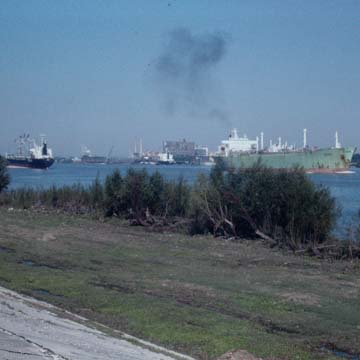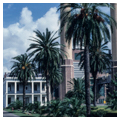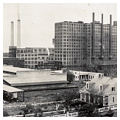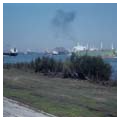The American Sugar Refinery, which owned refineries in Brooklyn, Jersey City, Boston, and Philadelphia, began construction on this plant beside the Mississippi River in 1905 and started processing sugarcane here in 1909. Constructed to plans prepared by the company, the refinery, which was described as one of the largest in the world at the time, included a wharf on the Mississippi River and vast warehouses. Of the many concrete-frame and brick-faced structures in this plant, the fourteen-story filter house is the tallest. Here the liquid sugar solution flows by gravity from storage tanks on the upper floor through filter tanks filled with bone char, which removes impurities and whitens the sugar. Other structures include the twelve-story pan house and nine-story granulator, where the sugar is dried, granulated, and pulverized. A pair of 225-foot-high cylindrical brick smokestacks flanks the powerhouse, glorifying it as a twin-towered cathedral of industry. The powerhouse, which originally supplied all the plant’s electrical needs, has a facade articulated by an enormous inverted V-shaped vent. Bricks for the buildings were manufactured in brickyards north of Lake Pontchartrain. The contractor for the building was James Stewart & Co. of St. Louis, Missouri. Over the years additional processing buildings have been added to the site.
Within the refinery’s grounds is Cavaroc House (c. 1840), built by the Paul Darcantel family on its brickyard, though the house is now known by the name of businessman Pierre Charles Cavaroc, who owned it from 1860 to 1880. The two-story, stucco-covered brick structure is surrounded by a two-story gallery on square Doric piers and has a hipped roof with dormers on all four sides. The American Sugar Company acquired the house when it purchased the land for its refinery.
Just upriver (to the left) of Domino is the two-story former Ford Assembly Plant (1922–1923, Albert Kahn), where the company’s automobiles were assembled, tested, and distributed for the southern market. The reinforced-concrete building has red brick spandrels and a narrow dentiled cornice. The plant closed in 1930, then operated sporadically under different ownerships as a testing or distribution center until 1977 when it became a warehouse. Flooded in Hurricane Katrina, the building awaits a new use.







